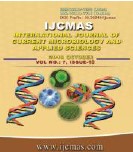


 National Academy of Agricultural Sciences (NAAS)
National Academy of Agricultural Sciences (NAAS)

|
PRINT ISSN : 2319-7692
Online ISSN : 2319-7706 Issues : 12 per year Publisher : Excellent Publishers Email : editorijcmas@gmail.com / submit@ijcmas.com Editor-in-chief: Dr.M.Prakash Index Copernicus ICV 2018: 95.39 NAAS RATING 2020: 5.38 |
A field experiment was conducted during rabi 2016-17 at Research farm of Punjab Agricultural University, Ludhiana involving two barley (Hordeum vulgare L.) varieties: V1 (DWRUB 52, Two-rowed) and V2 (PL 807, Six-rowed) sown on three sowing dates viz. D1 (25th October), D2 (10th November), D3 (25th November) and three irrigation levels viz. I1 (Recommended 4 post sowing irrigation), I2 (Skip at vegetative stage), I3 (Skip at anthesis stage) replicated thrice in factorial split plot design to investigate heat summation indices in relation to crop phenology under changed microclimate. Among different sowing windows, V1 took more number of days (158) along with highest AGDD (2059.45 oC day) to attain physiological maturity as compared to V2 (155 days and 1983.75 0C day) under D2. Phenological models explained 94 to 99 per cent variation in crop phenology due to heat units under three dates of sowing.V1 produced more plant height and tiller numbers (89.26 cm and 332 per m2 respectively) than V2 whereas D2 recorded maximum value of these attributes (91.53 cm and 362.06 per m2 respectively) followed by D1 and D3 at harvest and 90 DAS respectively. Heat use efficiency reflected positive linear relationship with different growth components and economic yield of crop.
 |
 |
 |
 |
 |